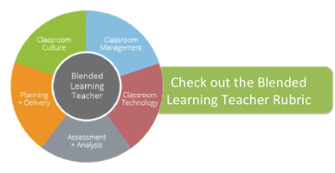As one of today’s most promising models for learning, blended learning is growing rapidly across the country. But what is blended learning, and how can educators use it to improve student outcomes?
In a blended learning environment, students learn through a combination of online instruction – with some element of student control over time, place, path, and/or pace – and instruction in a supervised brick-and-mortar location away from home. There are several different blended models that schools and districts can customize or combine to meet their specific needs.
Blended learning makes it possible to adapt the classroom model to better support both the teachers’ ability to differentiate instruction and their more frequent use of data to inform instruction. By connecting the modalities along each student’s learning path in a course or subject, educators can then provide their students with an integrated learning experience. This learning model also engages students in ways that they are already accustomed to, thanks to today’s technology-driven world and the increasing focus on personalized experiences. It also empowers teachers to be student-centered providers of learning.
One of the reasons blended learning holds great promise is that it magnifies the impact of a single teacher who is responsible for many students, all at different stages of readiness for learning. Educators have been trying to personalize learning and focus on competency for all students for decades. Only now that there are new technology tools that can empower differentiation for all students do teachers have the means to create dynamic individual learning pathways.
With blended learning models, rich data on student competency can be provided to educators in ways never before possible, saving time and effort while simultaneously permitting real-time feedback.
This plethora of data serves as an embedded formative assessment: an essential, ongoing, highly integrated component of the learning process.
Given the competing demands on teachers, leveraging this new influx of data to support their current efforts and better meet the needs of their students is essential. By using the data as assessment “for learning” rather than “of learning,” teachers can tailor their instruction to target specific skill or concept deficits. At the same time, students are empowered to continuously assess their own progress, which in turn fosters a greater sense of ownership and responsibility – important habits of mind needed for college and career readiness.
The emergence of these improved adaptive technology systems to support personalized learning is a game-changer, expanding the degree to which instruction can be differentiated. Among the many digital options available, I believe that Achieve3000 is the only solution that delivers a patented, adaptive approach that combines assessment and instruction to deliver effective online differentiated instruction.
The teaching profession is undergoing a dramatic transformation. Policy shifts, new assessments, and increased scrutiny have led to the need for a close inspection of current practices. Blended learning offers a way to maximize the time spent in classrooms by creating additional opportunities for teachers to deliver small-group or individualized instruction, while allowing students to self-direct their learning through digital content. It represents a transformative change in the traditional school model to meet the more rigorous challenges of today’s world.
In other words, blended learning is changing the face of PreK-12 education because it is more than a technology fad; it is a fundamental shift in instructional practice that will improve student outcomes for future generations.
--
This post is adapted from an original article in Achieve3000's 2016 Education Trends Report. Achieve3000 is the leader in online differentiated literacy instruction, serving over two million students worldwide. Based on decades of scientific research, Achieve3000’s cloud-based solutions for grades PreK-12 reach students at their individual reading levels to accelerate their learning, improve high-stakes test performance, and prepare them for college and career success.




